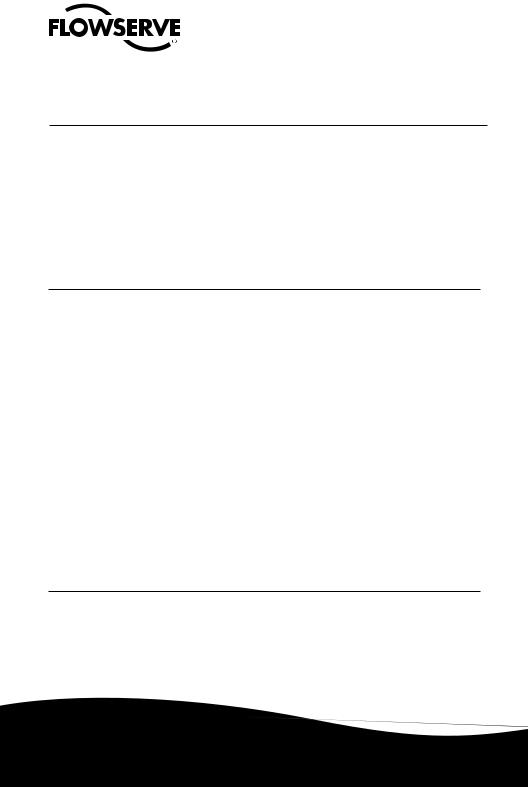Flowserve Mechanical Seal User Manual

Flowserve Mechanical Seal and Seal Support System Storage
1 Mechanical Seals - General Note
Mechanical seals are precision products and therefore require careful handling and storage to ensure reliable operation. If the mechanical seals are stored for an extended period of time before installation or commissioning, the storage conditions may adversely affect the performance of the seal once it is put into operation. For this reason the user must ensure the storage conditions will meet the recommendations stated below.
This guideline applies to Flowserve mechanical seals for centrifugal pumps, mixers, and reactors. Flowserve mechanical seals from the Gaspac product line should use Gaspac Guideline No. 39.
Flowserve will not accept any warranty claims for failures as a result of inadequate storage.
2 Storage of Mechanical Seals in Their Original Packaging
Flowserve mechanical seals are shipped in packaging which is intended to protect the seal from damage due to shipping and handling. This packaging is also suitable for long term storage. If the packaging is opened and the seal removed for inspection, the seal should be repackaged and resealed in its original packaging material and container.
While the packaging is suitable to protect the seal from damage due to normal handling, it is not designed to protect the seal from handling abuse or poor storage conditions. The seal must also be stored in an environment which will prevent damage to the seal.
Environmental guidelines for mechanical seals:
•Temperature range 4°C to 37°C (40°F to 100°F)
•Low humidity, less than 65% RH
•Atmosphere free from rain, dust, steam, chemicals, oils, radiation and ozone
•Storage surface free from impact and vibrations
Any loose gaskets should remain in their original packaging during storage.
If the seals will be stored in an outside location and exposed to more extreme environmental conditions or humidity/moisture, special packaging and seal preparation will be required.
3 Storage of Mechanical Seals Installed in Equipment which is Not Commissioned
Some centrifugal pumps will be stored for months or years prior to installation and final commissioning. The purchaser needs to consider the long-term storage requirements of the pump, bearings, and motors and resolve conflicts with storage of the mechanical seals and seal support system. The storage requirements of the pump may not be compatible with seal requirements and the seals may need to be stored separately from the pump. In this case, the mechanical seals should be stored in accordance with Storage of Mechanical Seals in Their Original Packaging.
Experience In Motion

If a mechanical seal is stored installed in a centrifugal pump, the preparation and storage conditions for both components must be considered together. In many cases, the centrifugal pumps are performance tested or hydrostatic tested on water prior to storage. The pump and seals must be dried before storage. This will require completely draining the pump, seal, and seal support system. Blowing dry air or nitrogen through the seal chamber and seal support system can aid in drying out these cavities.
Some pump storage procedures require that oils or liquid phase corrosion inhibitors are used inside the pump casing to prevent corrosion. These products can potentially damage the mechanicals seals if they come into contact with the seal components. Vapor phase inhibitors which do not leave a film or residue on the surfaces present less hazards to the seals. The use of desiccants or drying agents to absorb water vapors in the pump casing is the best solution for mechanical seals.
All openings on the pump, seals, and seal support systems must be flanged or plugged to isolate the pump casing from the environment. Blank flanges should be gasketed and threaded connections should be plugged with a suitable plug and sealant. The clearance between the seal gland and shaft
(in the area of the drive collar) should be masked off to prevent atmospheric contamination, debris or water from entering the seal gland.
Many pump storage procedures require that the shaft be rotated several revolutions by hand at regular intervals. This may serve the function of lubricating the bearings, preventing brinelling in the bearings, or minimizing shaft sag. The mechanical seals can tolerate this procedure without damage. Any masking between the seal gland and shaft that is removed during shaft rotation must be reapplied when complete.
4 Expected Storage Life
For storage periods longer than two years, environmental conditions may influence the flatness of rotating and stationary seal faces and cause deterioration of some gasket materials. After two years of storage, Flowserve recommends onsite professional inspection and static testing of product assemblies prior to commissioning by a Flowserve representative. After three years of storage, Flowserve recommends that mechanical seals are returned to a Flowserve facility for inspection and air testing.
Damage and contamination of internal mechanical seal components may not be readily apparent. The condition of the packaging or pump in which the seal was stored may provide indicators of corrosion, physical damage, water damage, or a dusty storage environment. If the mechanical seals have been stored in conditions not meeting the recommendations above or if the storage life history is unknown, the user should return the seals to a Flowserve facility for inspection and air testing prior to use. Failure to confirm the integrity of improperly stored mechanical seals could lead to excess leakage and seal damage during commissioning.
5 Air Testing of Pump Assemblies
Users should consider air testing the complete pump and seal package prior to final installation.
This procedure commonly consists of blocking in the pump, pressurizing the pump to a low pressure (typically 1.7 bar or 25 psi), and measuring the pressure decay over a defined period of time (typically 30 minutes). Pump assemblies which have excessive pressure decay should be examined to determine the source of the leakage and take corrective actions. If the seal is determined to be leaking, it is recommended that the seal be inspected by a Flowserve specialist.
In dual seals, the static air test should be repeated on the buffer/barrier/containment seal chamber to confirm the integrity of the outboard seal. Non-contacting seals designed to run on nitrogen should be statically tested with nitrogen.
6 Additional Information
The requirements and recommendations in this document are applicable to a wide range of mechanical seals and products. For additional information or for a review of special storage requirements, please contact your Flowserve representative.
2
